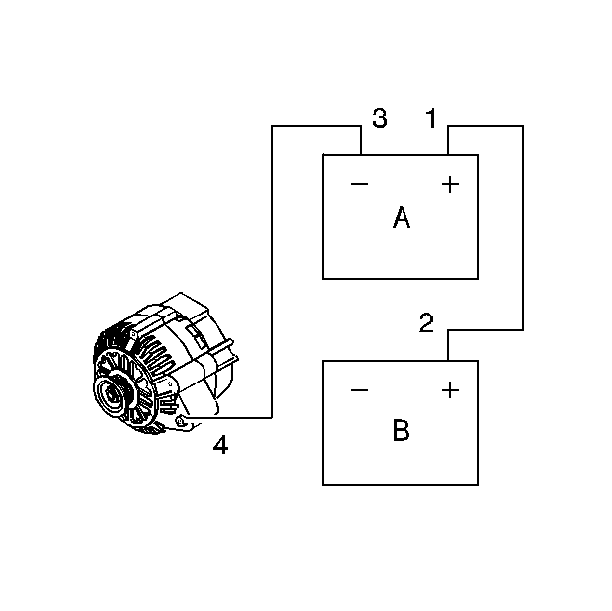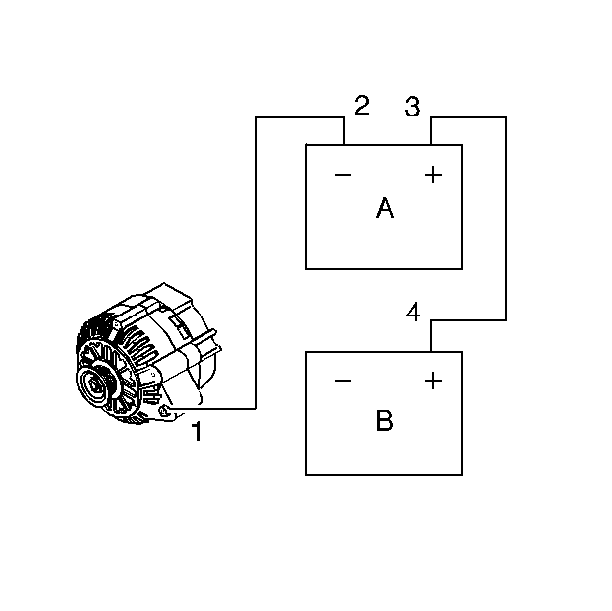Caution: Batteries produce explosive gases, contain corrosive acid, and supply levels
of electrical current high enough to cause burns. Therefore, to reduce the risk of
personal injury when working near a battery:
• Always shield your eyes and avoid leaning over the battery whenever possible. • Do not expose the battery to open flames or sparks. • Do not allow the battery electrolyte to contact the eyes or the skin.
Flush immediately and thoroughly any contacted areas with water and get medical help. • Follow each step of the jump starting procedure in order. • Treat both the booster and the discharged batteries carefully when using
the jumper cables.
Caution: Do not connect a jumper cable directly to the negative terminal of a discharged battery to prevent sparking and possible explosion of battery gases.
Notice: This vehicle has a 12-volt, negative ground electrical system. Make sure the vehicle or the equipment used to jump start the engine has a 12-volt, negative ground system. Use of any other type of system may damage electrical components.
Notice: Do not push or tow the vehicle to start it. Damage to the emission system and/or to other parts of the vehicle may result.
- Position the vehicle with the booster (charged) battery so that the jumper cables will reach the discharged battery. Do not allow the vehicles to touch.
- Place the automatic transmission in PARK.
- Set the parking brake.
- Block the wheels.
- Turn all the electrical loads that are not needed OFF (leave the hazard flashers ON as needed).
- Turn OFF the ignition switch.
- Check the built-in battery hydrometer of the discharged battery.
- Attach the end of one jumper cable to the positive terminal of the booster battery (A 1).
- A remote positive stud is provided for jump starting. The stud is covered by a red plastic flap and is located on the right side of the accessory wiring junction block. Attach the other end of the same cable to the positive terminal of the discharged battery or the remote positive stud (B 2). (A) is the booster battery, (B) is the discharged battery. Never connect positive to negative.
- Attach one end of the remaining jumper cable to the negative terminal of the booster battery (A 3).
- The final connection (4) is made to a solid engine ground, such as the generator mounting bracket or a ground stud, away from the discharged battery (B). Verify the cables are not on or near pulleys, fans or other parts that will move when the engine starts.
- Start the engine of the vehicle that is providing the boost. Run the engine at a moderate speed, approximately 1500 RPM, for several minutes.
- Crank the engine of the vehicle with the discharged battery.
- The negative jumper cable must be disconnected from the battery that was boosted, first (A 1).
- Remove the other end of the negative jumper cable from the booster battery (A 2).
- Remove the positive jumper cable from the booster battery (A 3).
- Remove the positive jumper cable from the other battery (B 4).
Make sure the jumper cables do not have loose or missing insulation.
If the hydrometer is clear or light yellow, do not jump (charge) the battery. Replace the battery. Refer to Battery Replacement .

A spark could ignite an accumulation of hydrogen gas from the discharged battery.

Do not let the cable end touch any metal (until after the other cable end is disconnected).
